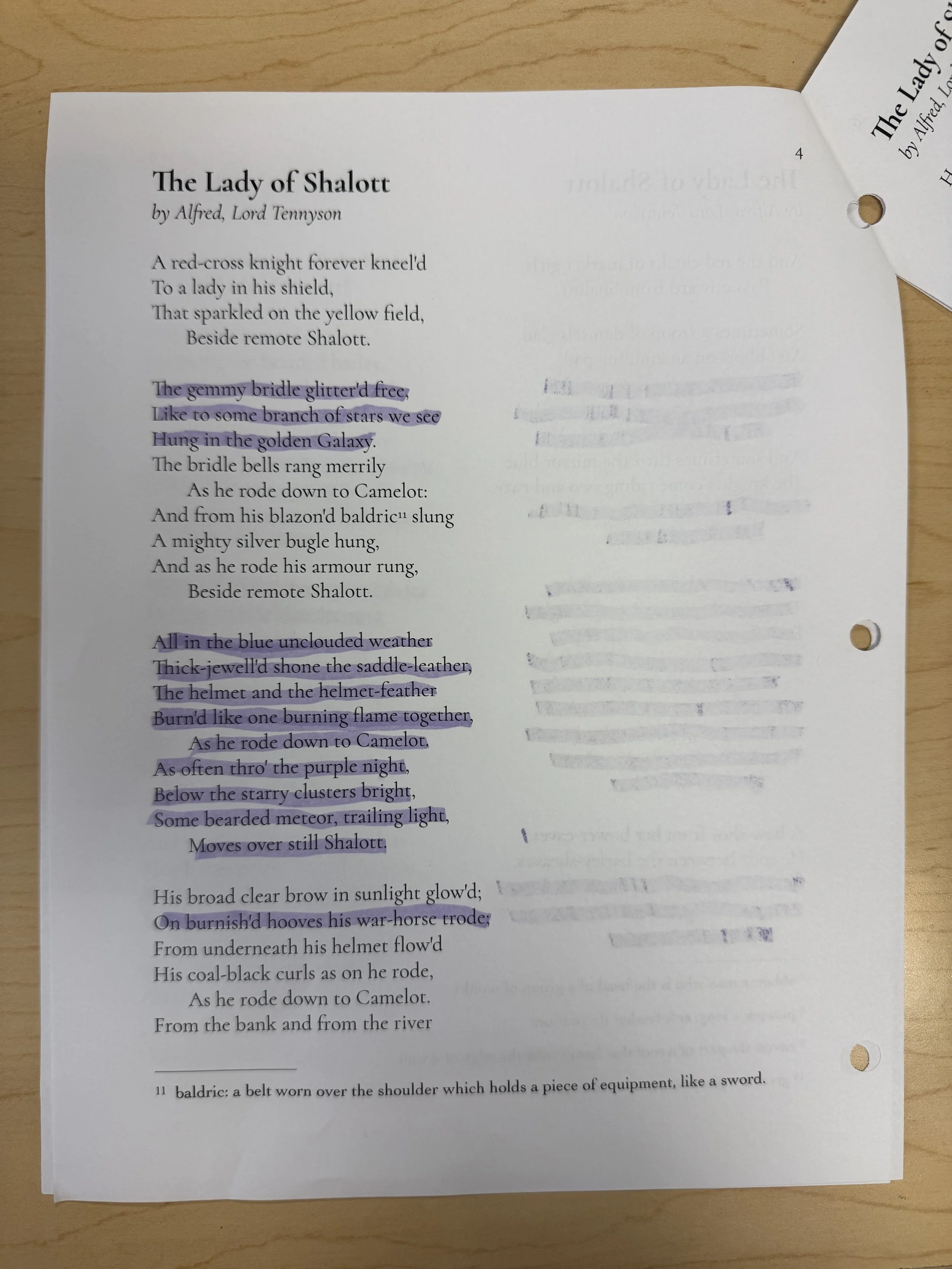Living and breathing in the skin of an admirable character is one of the best ways to connect with literature and make it a part of our lives. My 5th grade students got a taste of that this week when we spent two class periods reading Alfred Tennyson’s “The Lady of Shalott.”
I teach “The Lady of Shalott” to my 5th graders every year when we read Anne of Green Gables, as there is a scene in the novel when Anne and her friends act out the poem, with hilarious results. I love sharing it because it helps them appreciate that moment in the story, but more than that, it is filled with beautiful language that our romantic Anne Shirley would certainly say “gives her a thrill.”
During the first class period, we read through the poem together line by line, and they got to know the story. Then, on the following day, we read through it again. This time, they had highlighters.
“When we come to a line you think would give Anne a ‘thrill,’ just look up at me,” I said, “When a lot of you are looking at me all at once, I’ll know we’ve found a winner. We will highlight those lines.”
My students were well-prepared for this. We have spent weeks getting to know Anne, reading the poetry she references, laughing lovingly at her romantic stories and phrases. They got the idea right away.
I began reading the poem aloud from the beginning, and right when we arrived at the line, “Willows whiten, aspens quiver,” all 17 pairs of eyes were on me. Again, when we read, “the shallop flitteth, silken-sailed,” it was a unanimous, wide-eyed stare. The “curly shepherd-lad,” too, received much recognition, along with the knights who “come riding two by two,” and the fact that “She hath no loyal knight and true, The Lady of Shalott.”
But then, something happened that I didn’t anticipate.
When we arrived at the world-shaking description of Sir Lancelot riding through the barley field, my students just about lost their minds. No longer were they contented to merely look up at me when I arrived at a thrilling line. Oh, no. One boy could barely keep himself seated when he felt sure we had arrived at a line that must be highlighted. “Oh, come on!” one of them shouted when I didn’t stop and have them highlight after saying, “The gemmy bridle glitter’d free.” (Don’t worry—I did stop. I just knew they would also want to include the next lines: “Like to some branch of stars we see Hung in the golden Galaxy.”)
When I read about the helmet and the helmet feather burning “like one burning flame together,” a normally very quiet boy said, “I just got the chills.” Several times, when I stopped to indicate which lines everyone should highlight, students called out, “I don’t even care what you guys think, I’m highlighting the two lines before that, too!” “I must highlight the WHOLE STANZA,” one girl asserted. In short, it was a frenzy of appreciation for romance.
When we reached the end, my students were vibrating. At the end of class, without any kind of prompting, several students approached me and said, “Mrs. Steele, I love this poem so much.”
Through the embodiment of Anne’s effusive love of beauty, they too felt overwhelmed by the lyrical lines of “The Lady of Shalott.” By donning Anne’s persona for merely a few minutes, they fell in love with a timeless piece of art that they will recall fondly forever. More importantly, this fond feeling will certainly engage them in the beauty of poetry for the rest of their lives.
I have noticed similar phenomena, even in very young students, when I have asked students to write in the style of a particular character. Our 2nd grade students write letters to Sarah from Sarah, Plain and Tall, in the guise of the children Anna and Caleb. The 4th graders create imaginative fairy tales in the style of Sara from A Little Princess. The 6th graders embody Edmond Dantés from The Count of Monte Cristo when they recite Thomas Hardy’s poem, “Hap.” In each case, the engagement of the student is increased, and so is the value they gain from what we read.
Happily, this ability to temporarily masquerade as a fictional character will pay increasing dividends across the years to come. The books they will read are brimming with such characters as Marguerite Blakeney, Cyrano de Bergerac, and Jean Val Jean. By encouraging this personal connection, we bring the values of some of literature’s most admirable heroes right home to the hearts of our students, and it makes them stronger. With the ability to don the honesty, bravery, heroism, and romanticism of these characters, those traits become theirs too, and nothing evil will ever touch our students with its wings.
